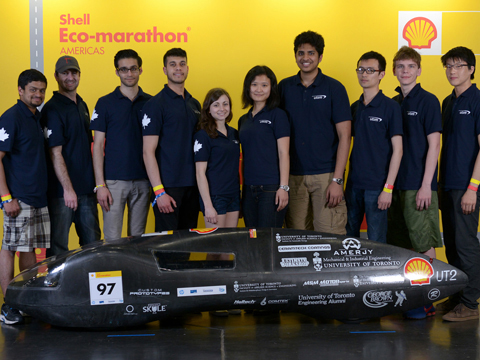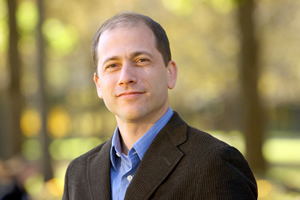By 2025, the United States will require new cars to travel 23 kilometres on a litre of gas, on average – nearly double today’s standards. The drive for fuel efficiency is part of efforts to make cars more environmentally friendly, and the U.S. more energy independent.
Sound ambitious?
Maybe not, when you consider the 1,152 kilometres on a single litre of fuel attained by a car created by a group of U of T engineering students that competed in Shell’s 2014 Eco-marathon contest.
“We changed the competition completely,” says Jonathan Hamway, co-president and lead designer for U of T’s Supermileage team. “We definitely inspired people, and that was the best part of the competition.”
The Eco-marathon is all about inspiration – many of the advances proven on the competition’s closed track are not directly translatable to ordinary vehicles. But they show what’s possible for fuel efficiency. The Supermileage team snagged awards for both technical innovation and tribology (the study of friction, lubrication and wear on surfaces in motion). They placed second overall behind a team from Université de Laval who managed to travel 1,200 kilometres.
Hamway is confident they can do better in 2015. While most competitors used an off-the-shelf engine – the Laval team used one from a lawn mower – Hamway’s team custom-built an engine that allowed them to control every variable – from fuel delivery to engine coatings. They even captured the engine’s heat, turning that normally wasted energy into additional power. The team also focused on many areas beyond engine efficiency.
The Supermileage Car’s light, strong carbon-fibre body looks like a missile with wheels – highly aerodynamic (if impractical for a family outing). Their driving strategy involved getting the car up over the competition’s minimum required speed, and then cutting the engine for as long as possible. “Our engine was actually off for most of the race,” Hamway explains. “One in every five tanks of gas in a regular car is used up overcoming resistance from tires,” he says. “We have the best tires in the whole world for reducing that resistance.”
Unfortunately, these specialized tires have neither the durability nor the wet weather traction to make them widely usable. In fact, the first real-world applications for their technologies might not be in cars at all, but in vehicles with smaller engines.
“Some of our modifications could be used to make a scooter that is much more efficient than anything available today,” he says.
The team’s current focus, though, is less on knowledge translation and more on next year’s competition, and the continued push to raise the absolute limits of fuel efficiency.

Recent Posts
For Greener Buildings, We Need to Rethink How We Construct Them
To meet its pledge to be carbon neutral by 2050, Canada needs to cut emissions from the construction industry. Architecture prof Kelly Doran has ideas
U of T’s 197th Birthday Quiz
Test your knowledge of all things U of T in honour of the university’s 197th anniversary on March 15!
Are Cold Plunges Good for You?
Research suggests they are, in three ways





